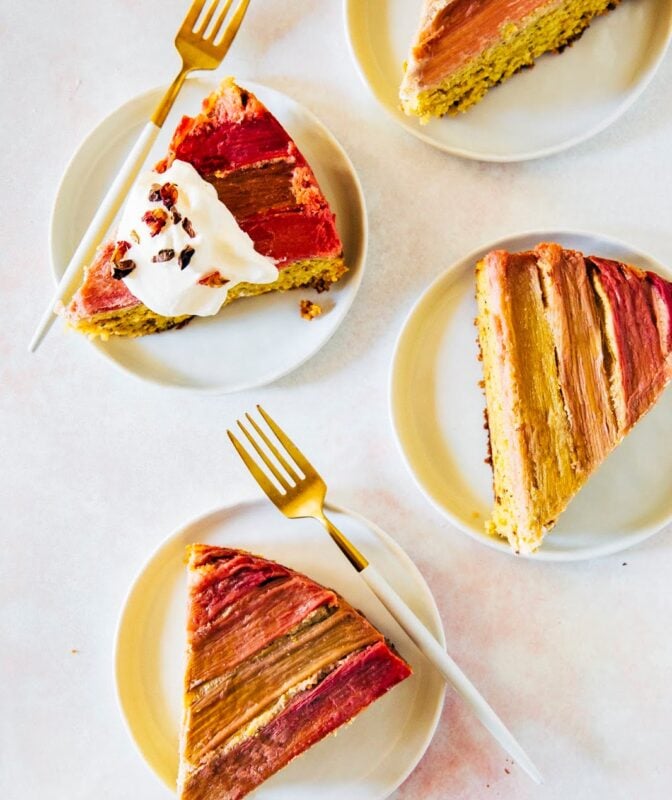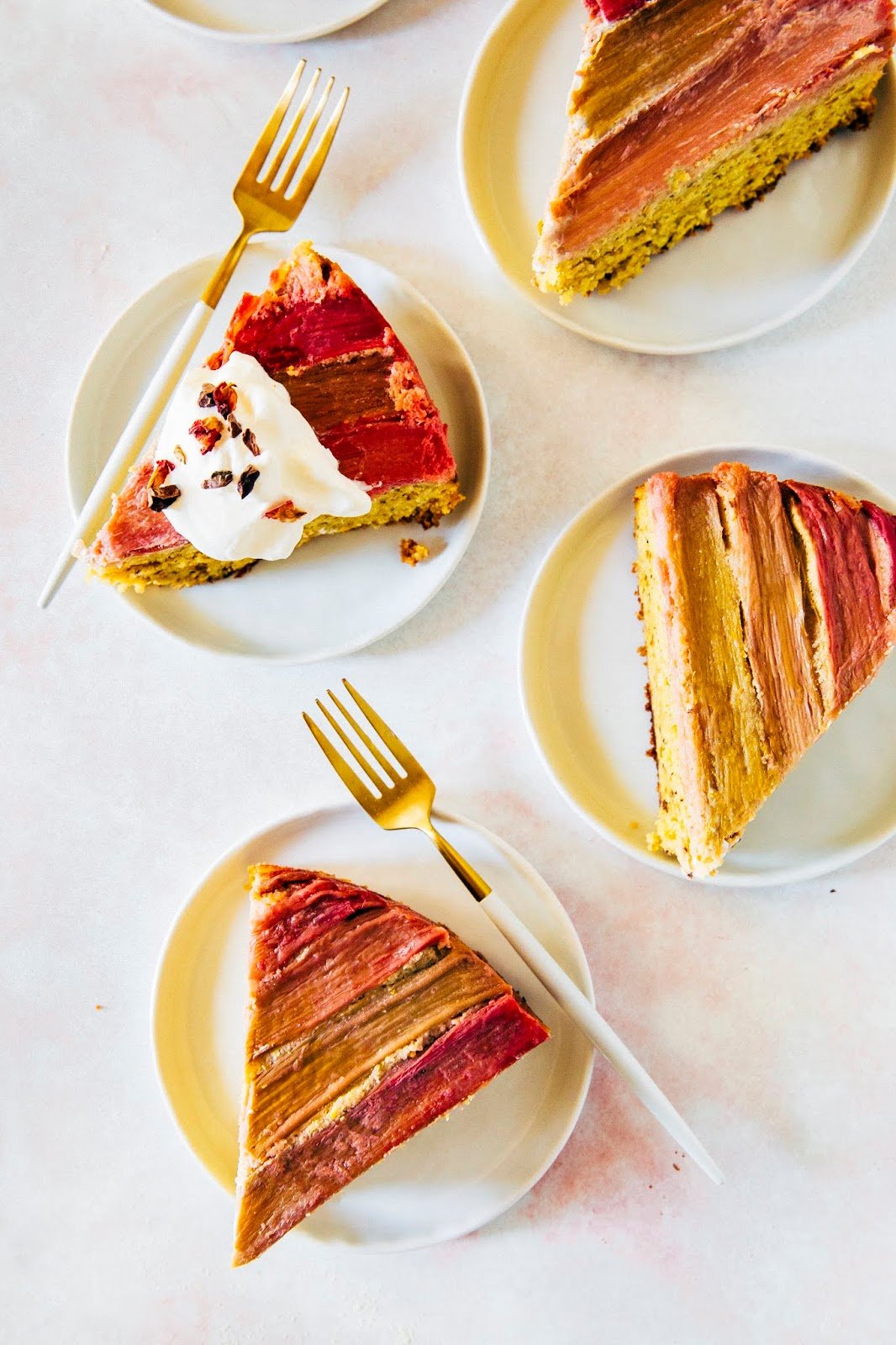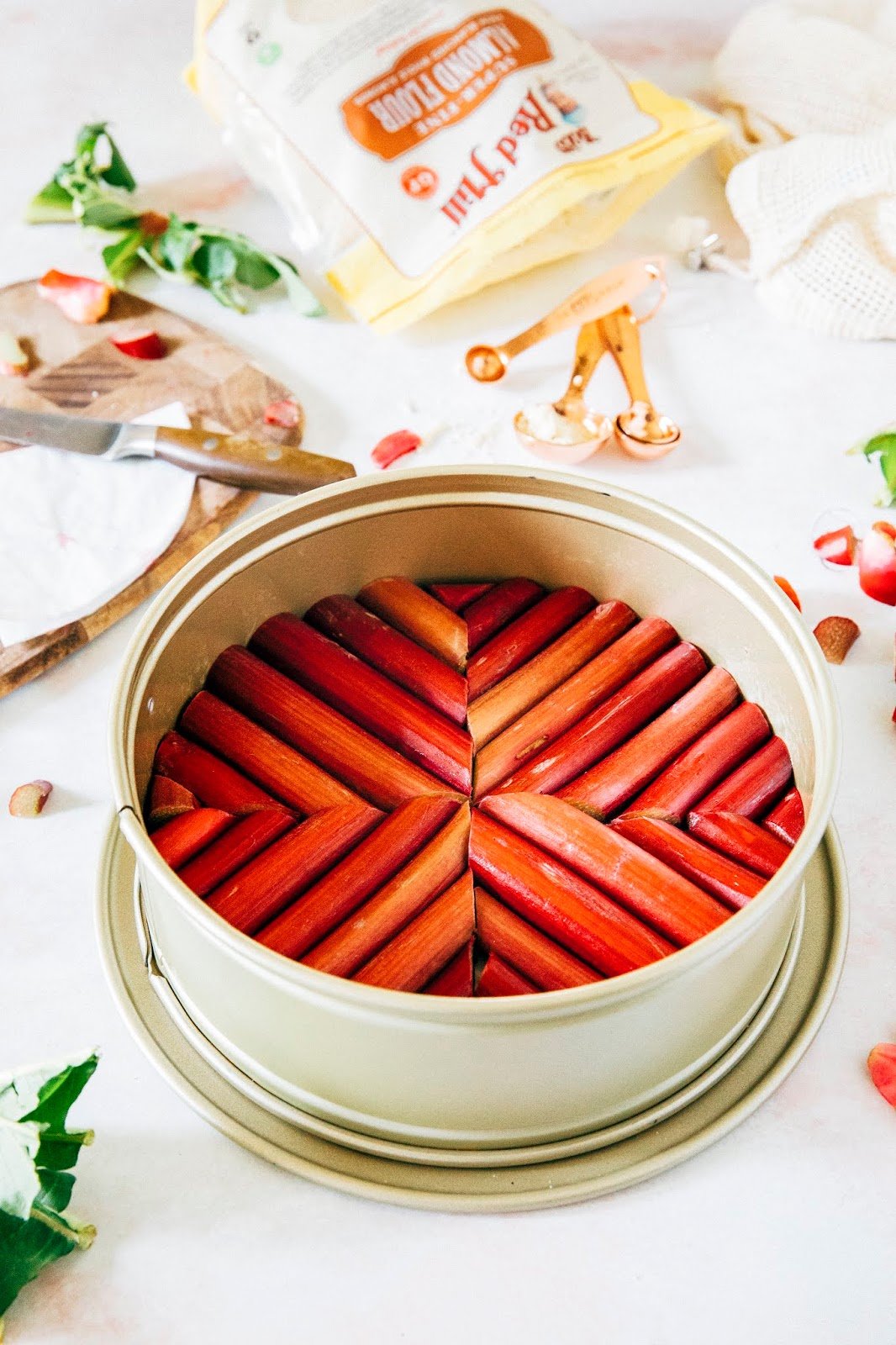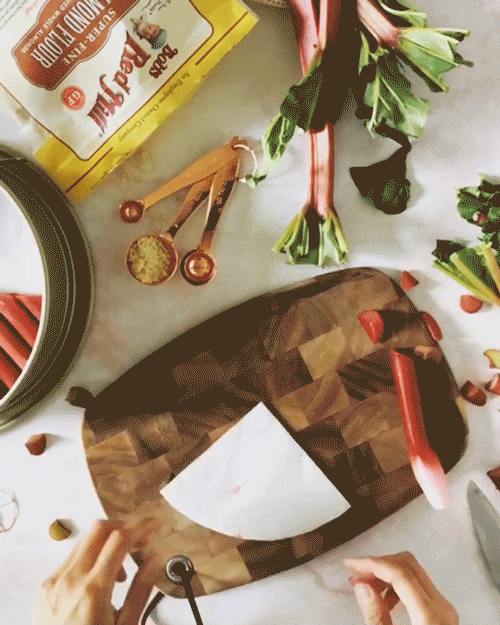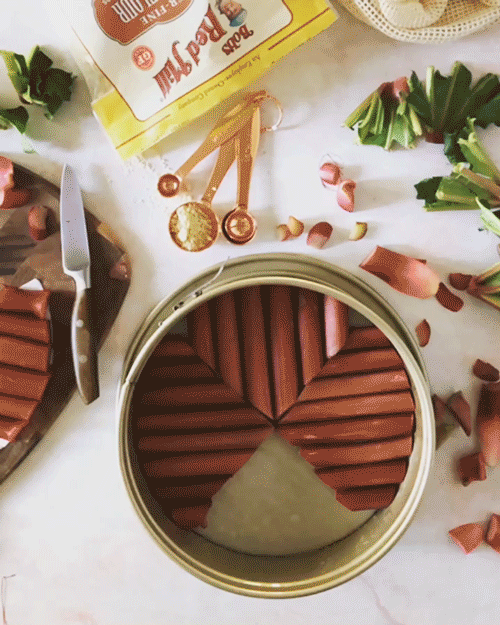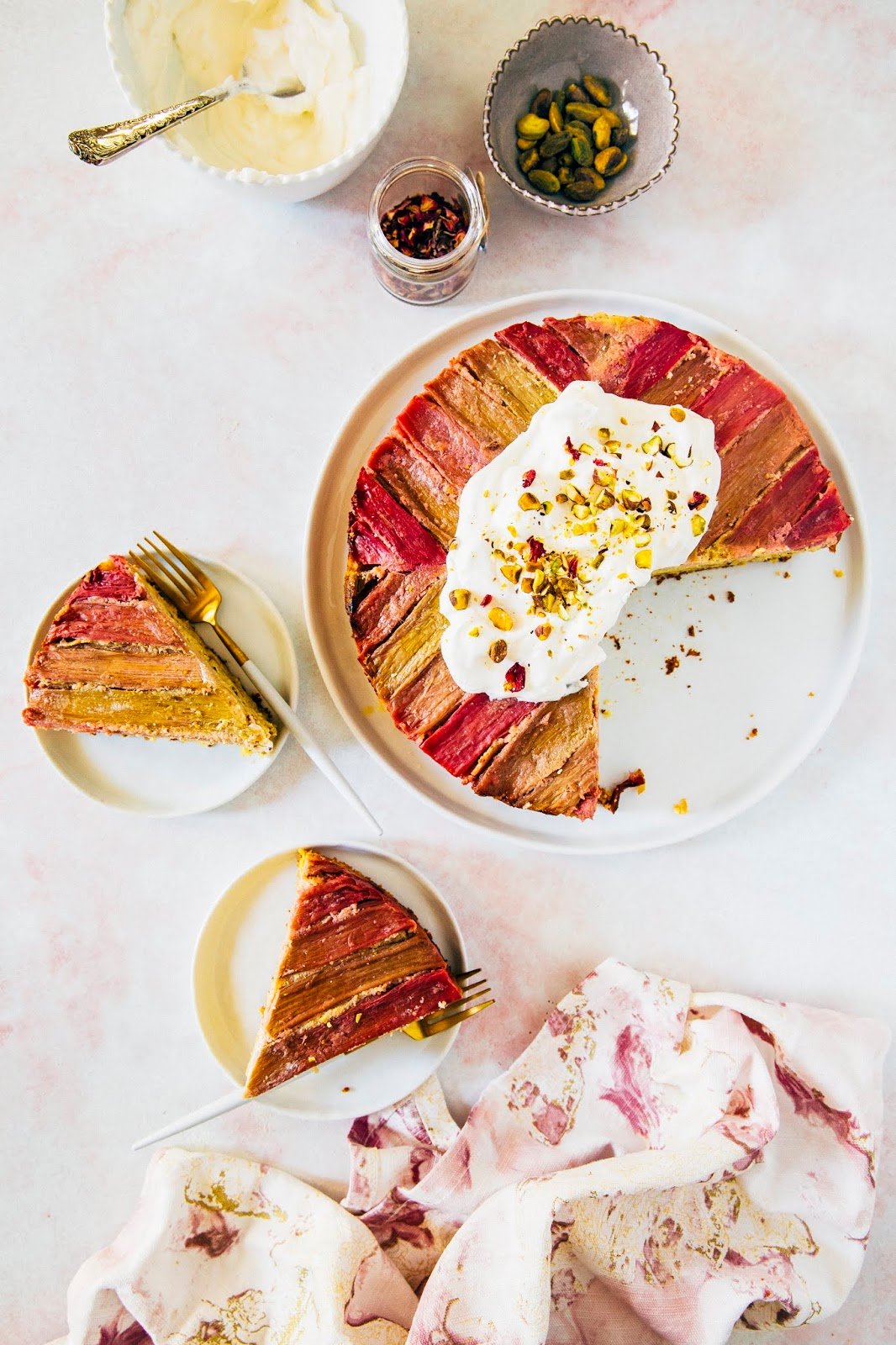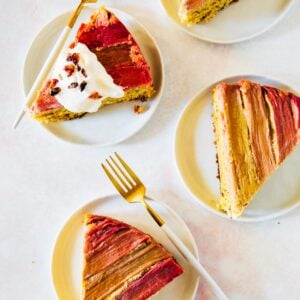This post is sponsored by Bob’s Red Mill, who provided the ingredients and compensation to make this recipe happen! I use Bob’s Red Mill products in all my baking, and I’m excited to be partnering with them all year long. Thank you for supporting the sponsors that keep Hummingbird High up and running!
Rhubarb season is officially in full swing in Portland—both the farmers markets and grocery stores have bundles of the vegetable (apparently it’s a vegetable and not a fruit!). If I’m being 100% honest with y’all, it’s actually not my favorite thing to eat? Raw rhubarb is bitter and tough, while baked rhubarb can be stringy and astringent (however, I did have the opportunity to try “forced” rhubarb when I was last in London; forced rhubarb is when the vegetable is grown in dim lighting conditions, resulting in a pinker, softer, and sweeter stalks—it was delicious!).
And yet, despite my lukewarm feelings towards rhubarb, I can’t help but get excited when I see the first few stalks in the springtime. I think it’s maybe because of a combination of their vibrant pink color and the fact that their appearance in the supermarket means that spring is officially here and we have days of sunshine ahead of us. I’ve also noticed many talented bakers making fun, geometric patterns with their rhubarb on top of tarts (like this one and this one), and wanted to give it a try for myself:
The pattern itself wasn’t difficult to make; I followed this tutorial by Herriot Grace, who also has a video of how to cut and arrange the rhubarb stalks. The trick is to use a template made from a folded up piece of parchment paper or stiff cardboard to slice the rhubarb into even lengths—from there, it pretty easy street:
I’m sure I’ve mentioned this already, but one of my favorite things to do while travel is to check out local grocery stores and supermarkets. Erlend and I recently just got back from a quick vacation to both London and Copenhagen, and I made sure to visit a handful of each in both cities. You can find all sorts of fruit, candy, and snacks that aren’t as easily available in the United States (to wit: Erlend found grains of paradise and cacao fruit in Torvehallerne in Copenhagen; while neither is native to Copenhagen, he was excited to see them since they aren’t sold in Portland AT ALL and spent a fair amount of krone sampling tiny amounts of each fruit).
While wandering the baking aisles of both London and Copenhagen, something stood out to me: both British and Danish folks seem to use more floral flavors in their baking. In both cities, the baking section had extracts like elderflower and rose water more readily available (in addition to some more unusual ones like sea buckthorn berries). In Copenhagen, I also noticed that the bread and pastries were almost always made with alternative flours like buckwheat and rye, giving them a more nuanced and tasty flavor.
It was with this in mind that my rhubarb geometry found itself under a pistachio, rose water, and semolina cake. The cake is adapted from Ottolenghi’s dessert cookbook, Sweet, and is made with a mix of ground pistachio nuts and Bob’s Red Mill Super-Fine Almond Flour. Because the pistachio nuts are coarsely ground and the almond meal is incredibly light and fine, there’s lovely, contrasting textures of nuts throughout every bite of cake. It’s also spiked with a healthy dose of semolina, a fine flour usually reserved for making delicate pastas in Italy. The flours give the cake a wonderfully earthy, nutty flavor, all the while remaining soft and fluffy like regular cake. The rose water complements the astringent rhubarb, tempering its sourness with a light floral flavor that would otherwise be too overpowering on its own. Enjoy!
Some baker’s notes:
-
- If you’re opting for the rhubarb geometric pattern, you’ll need around 2 pounds of rhubarb. For a super even design, make sure to get stalks that are equal in width (length doesn’t matter as much since you’ll be cutting and slicing them accordingly). Also opt for stalks that are incredibly pink and red—lighter stalks will lose their color in the oven.
-
- Be sure to source rose water, and NOT rose extract, for this recipe—the latter would be too overpowering in this cake. Rose water is typically available in the baking aisles of grocery stores; in a pinch, check the international or Middle Eastern aisles of your store.
- Bake Time is on the longer side because the rhubarb needs a fair amount of time in the oven to soften and cook; it will also vary greatly depending on how soft and ripe your rhubarb is. I’ve given you a starting point of 60 to 70 minutes, but I encourage you to rely on visual cues instead. Start checking for doneness at that mark; a done cake will have a perfectly set center that bounces back when gently poked, and a skewer inserted into the center of the cake will come out with few crumbs attached.
Get the Recipe: Pistachio, Rose Water, and Rhubarb Semolina Cake
Ingredients
- 2 pounds rhubarb (see baker's notes)
- 3 cardamom pods
- 1 cup (5.35 ounces) shelled pistachios
- 1 cup (3.5 ounces) Bob's Red Mill Super-Fine Almond Flour
- 3/4 cup plus 3 tablespoons (6 ounces) Bob's Red Mill Semolina Flour
- 1 1/4 teaspoons baking powder
- 1/4 teaspoon kosher salt
- 1 1/4 cups (10 ounces) unsalted butter, at room temperature
- 1 2/3 cups (11.65 ounces) granulated sugar
- zest of 1 medium lemon
- 4 large eggs, at room temperature
- 2 tablespoons rose water
- 1 tablespoon freshly squeezed lemon juice
- 1/2 teaspoon pure vanilla extract
Instructions
- Position a rack in the center of the oven and preheat to 350 (F). Generously spray the bottom and sides of a 9-inch springform pan with cooking spray and line the bottom with a parchment paper circle; spray the parchment as well.
- Prepare the rhubarb (see baker’s notes) and arrange as desired on the bottom of the pan.
- Use a sharp knife to split 3 cardamom pods lengthwise. Scrape the seeds into the bowl of a food processor. Add 1 cup shelled pistachios and pulse until the nuts are finely ground and resemble a coarse meal. Pour into a medium bowl and add 1 cup Bob's Red Mill Super-Fine Almond Flour, 3/4 cup plus 3 tablespoons Bob's Red Mill Semolina Pasta Flour, 1 1/4 teaspoons baking powder, and 1/4 teaspoon kosher salt. Whisk to combine.
- In the bowl of a stand mixer fitted with a paddle attachment, place 1 2/3 cups granulated sugar, 1 1/4 cup unsalted butter and zest of 1 medium lemon. Beat on medium-low for 2 to 3 minutes, or until just combined, using a rubber spatula to scrape down the bottom and sides of the bowl as needed. With the mixer on low, add 4 large eggs, one at a time, only adding the next egg when the previous one is incorporated, scraping down the bottom and sides of the bowl after every addition. With the mixer on low, add 2 tablespoons rose water, 1 tablespoon lemon juice, and 1/2 teaspoon vanilla extract, beating until just combined. Gradually add the dry ingredients (from the 4th step) and beat on low until just combined.
- Pour the batter over the rhubarb and use an offset spatula to smooth it evenly across the pan. Bake for 60 to 70 minutes, or until a skewer inserted into the center of the cake comes out with few crumbs attached. Cool the cake in its pan on a wire rack completely, before inverting onto a serving plate. Serve warm, or at room temperature, with a dollop of whipped cream and garnish of chopped pistachios.

